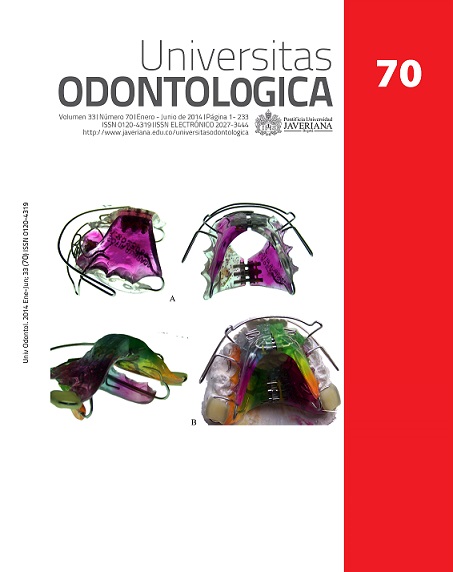Abstract
Antecedentes: No existe evidencia científica suficiente que respalde las ventajas del sistema de fuerzas de autoligado sobre el sistema de fuerzas convencional en ortodoncia. Objetivo: Comparar la expresión de OPG y RANKL en el ligamento periodontal de dientes sometidos a fuerzas ortodónticas generadas por dos sistemas de brackets de autoligado y convencional. Métodos: Se analizó la expresión de OPG y RANKL mediante RT-PCR en el ligamento periodontal de 40 dientes con indicación de extracción terapéutica para ortodoncia. El grupo experimental estuvo conformado por diez premolares que recibieron fuerzas con brackets de autoligado durante 15 días y 10 premolares que recibieron fuerzas con brackets de arco recto durante 15 días antes de la extracción; 20 premolares sirvieron como grupo control. Los datos fueron analizados mediante la prueba H de Kruskal-Wallis. Resultados: RANKL mostró un aumento estadísticamente significativo en el lado de presión de los dientes sometidos a los dos sistemas de fuerzas ortodónticas. OPG no mostró diferencias entre las zonas o entre los dos sistemas de fuerzas analizados. Conclusiones: No se encontraron diferencias en la expresión de RANKL y OPG en el ligamento periodontal de dientes movidos con técnica de ortodoncia de autoligado comparados con los movidos con técnica de arco recto.
PALABRAS CLAVE
osteoprotegerina; RANKL; autoligado; arco recto; respuesta biológica; fuerzas ortodónticas
This journal is registered under a Creative Commons Attribution 4.0 International Public License. Thus, this work may be reproduced, distributed, and publicly shared in digital format, as long as the names of the authors and Pontificia Universidad Javeriana are acknowledged. Others are allowed to quote, adapt, transform, auto-archive, republish, and create based on this material, for any purpose (even commercial ones), provided the authorship is duly acknowledged, a link to the original work is provided, and it is specified if changes have been made. Pontificia Universidad Javeriana does not hold the rights of published works and the authors are solely responsible for the contents of their works; they keep the moral, intellectual, privacy, and publicity rights.
Approving the intervention of the work (review, copy-editing, translation, layout) and the following outreach, are granted through an use license and not through an assignment of rights. This means the journal and Pontificia Universidad Javeriana cannot be held responsible for any ethical malpractice by the authors. As a consequence of the protection granted by the use license, the journal is not required to publish recantations or modify information already published, unless the errata stems from the editorial management process. Publishing contents in this journal does not generate royalties for contributors.


